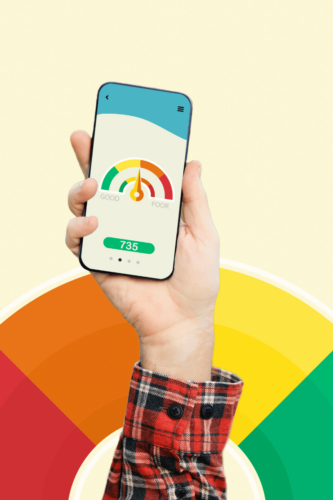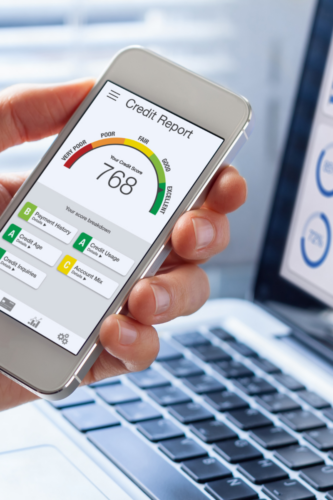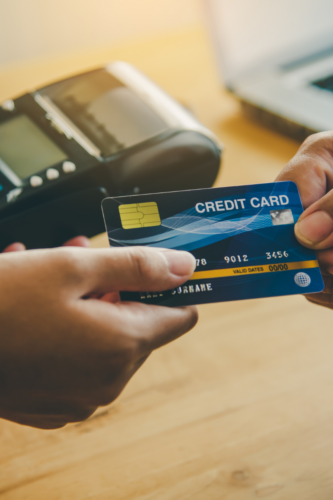Has anyone ever told you to take out a loan in order to improve your credit score?
AAAACK! That’s such a personal pet peeve of mine.
There are so many ways you can improve your credit score that don’t require you to pay interest. So. Many. Ways.
And while it’s true that….eventually (and I mean a pretty looooong eventually), that loan might give your FICO score a nudge, it’s absolutely not going to happen right away. Because taking out new credit always causes your credit score to dip, and sometimes, depending on the situation, it might dip by a lot.

3 Easy Steps To Improve Your Credit
So let’s talk about all the FREE and EASY steps you can take right now to improve your credit score. Or, if you have so little credit history that you don’t really have a credit score, these same steps will help you begin that process. All you need is some time while consistently applying these methods:
Step 1: Download the Experian Go app.
That name–Experian–might sound familiar. They are one of the major credit bureaus in the US. And they realized that young adults starting out or recent immigrants might want a way to jump into the credit fray without acquiring debt. So they are now allowing you to self-report regular bills that you pay on time, such as utilities and rent. Normally, utility companies and property management companies don’t report your payments to the credit bureaus because those payments don’t represent actual debt–they’re much more in the “bill” realm.
But if you’ve been a faithful bill payer, this now counts in the world of credit development. At least it counts with Experian. Here’s hoping that Equifax and TransUnion jump on this bandwagon too.
By signing up for Experian Go, you are also signing up for a fair bit of advertising and financial product marketing. Yuck, right? Except….see step #2….

Step 2: Open a Credit Card
After you begin self-reporting all those bills you pay on time, the next developmental step is to open a credit card. So filter all those ads and offers you’ll be getting and choose ONE card that will serve you well.
What does that mean–a card that will serve you well? We’d love for you to flip the attitude about credit cards, at least in your own head, and look for a card that is going to be a useful tool, and not something that becomes a bottomless pit of debt and discouragement. So if you think about your credit card as a tool and not as free money (because it isn’t free, not by another long shot), you can build your credit score responsibly.
Here are some things to look for in the best-for-you credit card:
–NO annual fee
–awesome rewards (personally, I adore cash back rewards. I totally understand if you want to earn airline miles or points, but here’s the deal: I don’t always use the miles or the points, but I can always use cash)
–know the interest rate…it’s a good idea to know exactly how much interest you’d be paying if you didn’t pay off the balance every month. But the whole point of this exercise is to use the card a little bit and pay it off immediately, in which case the interest rate is irrelevant on a practical level. (You also need to know that the interest on credit cards accrues daily, which, along with the typically high rates, makes credit card debt different from and much more insidious than just about every other type of debt.) So use the card as a tool, but never actually use it for debt.

Step 3: Use the Card
Use the card. A little. And pay it off immediately. Or, at the very least, pay it off BEFORE the statement date. The statement date is when your credit card company takes a snapshot of your balance due and sends it to the credit bureaus. If you make a habit of paying the card off all the way before the statement date, your use rate (the balance on the card compared to the credit limit on the card) will be below 10%, and that is all gold stars in credit land.
If you keep your use rate consistently below 10%, your credit score will go up. If your use rate creeps up to 30%, your credit score will plateau. The moment your use rate goes over 30%, your credit score will take a nosedive.
So it might help to decide the one thing you’ll use the card for–gas, or pick one utility to set up auto-billing for–and then pay off the card at least once a week. If you do that, you never have to worry about when the statement date is, and your use rate will stay in the healthy range.
By the way, there’s nothing wrong with a 0% use rate at the moment the statement snapshot is taken…in fact, that would be amazing! But you do need to use your card a little bit once in a while, or the company may close your account due to inactivity.

Why Do We Care About Credit Scores?
This might feel like a lot of nit-picking for nothing.
Your credit score becomes vitally important the next time you really do need to borrow money. For example, so you can buy a house. Or maybe a car. A great credit score (760 and higher) will get you the best possible interest rate available at that time. And save you a lot of money in the long run.
We are not fans of debt here at BCS, but we understand that just about nobody can pay cash for a house these days. And that sometimes things happen with vehicles that cause you to need to replace them before you’ve saved up enough to pay cash for that transaction. So debt happens. But we’d love for all our participant families to get to the point where the debt they choose is fully intentional, planned for, built into a healthy budget, and is in complete alignment with their Family Visions. And is signed for at the lowest possible interest rate!

Tina Birch
Tina is one of Birch’s Financial Literacy Counselors who meet with our participants regularly to discuss how to meet their financial goals. She is also an avid reader and writer so we are excited to have her share her knowledge about financial literacy with us here on The Birch Blog.
